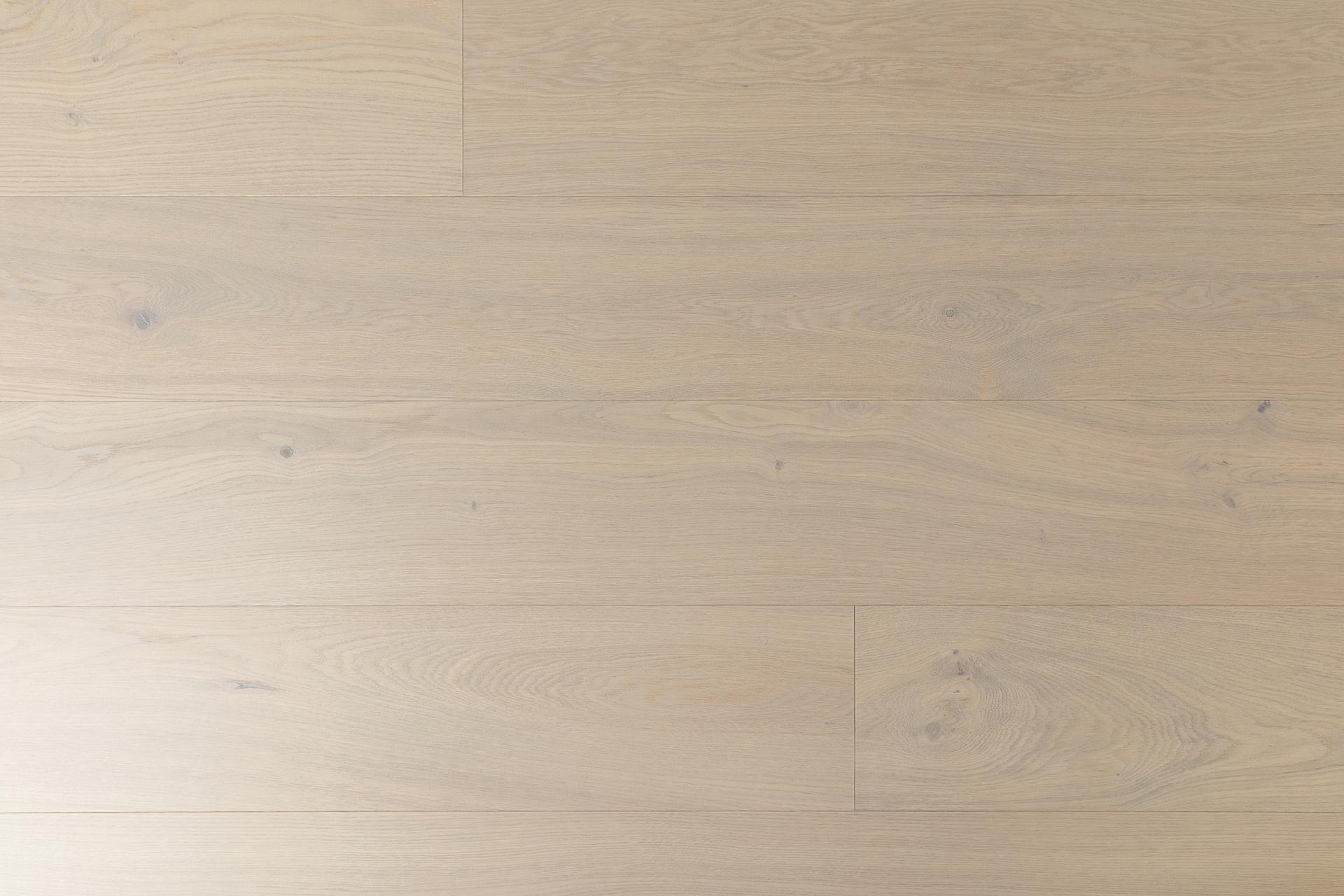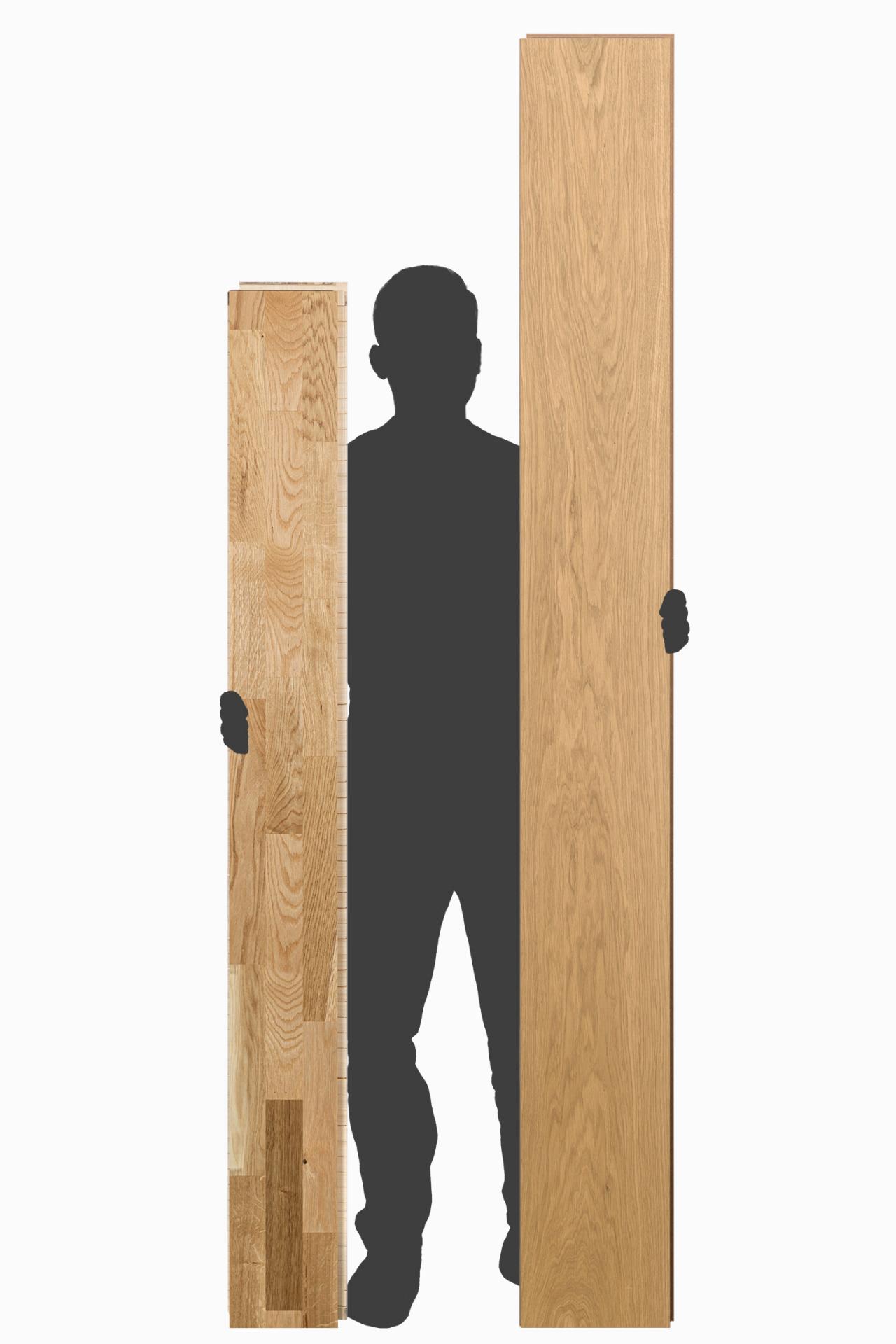
What does it cost to buy and install a wooden floor?
And what factors determine the total price?

Why is there such a big price difference on different wooden floors?
It is well known that the price per kilo for beef fillet is higher than for minced meat. In the same way it is with oak. Straight and long oak logs with a large diameter and without large cracks and lumps that are part of a Select sorting cost many times more than lower quality oak logs used in Rustic sorting. Only the inner parts of the oak can be used to make wide surface layers.This means that engineered floors that are long and wide without bumps and cracks become significantly more expensive than short and narrow ones with many twigs and cracks.Advanced surface treatments with deep brushing and coloring further increases the price. The thickness also affects the price because more wood material must be used. Thicker surface layers can be avoided several times and a thicker core provides a dimensionally stable floor that is flat even in large climatic variations.
3-strip parquet, which is made from waste pieces that are left over when making long and wide surface layers and which can be made from low-quality oak logs, is always significantly cheaper than 1-strip parquet of corresponding quality.
Hardened wood floors do not need to be made as thick as they are more stable in shape than traditional engineered floors and the hardened surface layer can be made thinner because sanding is not needed. The price difference for planks in different lengths and quality classes is significantly smaller because ten times more floors can be made from the same oak floor.
This means that you can manufacture large quantities of long and wide planks that also have clean surface layers. Such attractive hardened hardwood floors can be made cheaper than traditional engineered floors which are narrow and short and have lower quality finishes.
The price of flooring is also affected by where it is manufactured. In many cases, it is difficult to obtain information about where a floor is made. Flooring manufactured in Europe is generally more expensive and of better quality than flooring manufactured in Asia, where environmental requirements and wages are lower. We manufacture all our floors ourselves. When you buy a Bjelin floor, you are guaranteed a floor that is manufactured in Sweden or Croatia.
If you want a reasonably priced high-quality wood flooring in wide, long planks, you should choose a floor of hardened wood. If you want a traditional engineered floor, you should choose a floor that is not too thin, especially if it is wide, for shape stability.
How do I choose the right quality?
When choosing a floor, it is important that you also remember that a low price can be a bad buy if the quality is poor. An installed floor that has defects is very expensive to repair.
In addition to surface defects, it is common for poor floors to creak. This can be caused by a poorly fitting joint system where adjacent joint surfaces move and cause creaking. Another cause can be uneven or creaking subfloors.
To ensure high quality and avoid costly claims, all of Bjelin’s floors are manufactured on modern production lines in our own factories with click joints manufactured with the highest possible precision. We also manufacture all our own coatings.
The illustration shows a worn three-strip parquet floor with gaps in the joint system and a glued strip that has begun to come up.
Subfloor, Floor Thickness and Floor Heating
A good floor installation requires a flat and stable subfloor. If your subfloor is uneven, it must be rectified. Existing loose floor boards must be screwed in place, elevations must be sanded down and holes must be filled. The best results are achieved by using levelling compound on the entire subfloor or by installing a new subfloor.
In new builds, it is good to choose the floor type at an early stage so that doors and stairs can be adapted to the floor thickness.
In terms of costs and the environment, it is an advantage if the old floor can remain in place. Older floors often have gaps and dents. The new floor must be sufficiently stable to overcome such common defects. All of Bjelin’s floors are designed to be laid on an existing floor such as pine panels, parquet, laminate, plastic flooring or tiles. However, wall-to-wall carpet must be removed. Choose a floor that is not too thick to avoid having to adjust doors. A hardened wood floor could be a good choice in this case (light floor to the right in the illustration) as it is only 11 mm thick. Parquet floors (dark floor to the left in the illustration) are slightly thicker (14-15 mm).
If you have hydronic or electric floor heating, you need to choose a floor that can withstand temperature variations. A floor from Bjelin can be installed on all types of floor heating systems. Remember that a moisture barrier such as combi foam or age-resistant plastic must always be installed over a concrete floor structure or on floors with underfloor heating.
What does the installation cost?
All our floors are designed to be installed by anyone. However, herringbone floors with friezes should be installed by a professional.
Provided that the subfloor is flat and stable and that the floor is delivered to the home, the following required work steps will affect the cost when installed by a floor layer. If you choose to keep existing floor mouldings in your room and only add a small external moulding, the cost will be lower. Otherwise the mouldings must be removed.
The work of laying out base material and installing a click floor consisting of standard-sized floor boards with a high-quality click joint in a 4 x 4 m large room costs approx. SEK 250/m2 incl. VAT. The floor can be used immediately and the installation can be done in one day.
The majority of the cost comes from cutting the floor boards. The cost per m2 is lower in larger rooms and higher in smaller rooms. The cost also increases if the room contains many angles and corners. A herringbone floor that contains many strips usually takes twice as long to install and the cost can be around SEK 500/m2.
A floor installation in a room with many corners, in which the old floor is removed, the subfloor requires work and mouldings are replaced, can cost SEK 500-1000/m2. The cost may be significantly higher than the cost of the purchased floor. It is therefore important that the floor has a long service life. Fixing a bad subfloor is also a good investment for future floor changes. Low-cost floors with substandard click-joint systems can have a higher installation cost than high-quality floors in the higher price class.